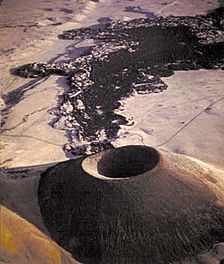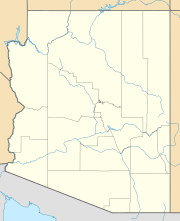S P Crater facts for kids
Quick facts for kids S P Mountain |
|
|---|---|
 |
|
| Highest point | |
| Elevation | 7,021 ft (2,140 m) NGVD 29 |
| Geography | |
| Location | Coconino County, Arizona, U.S. |
| Geology | |
| Age of rock | Approx. 71,000 yr [unreliable date] |
| Mountain type | Cinder cone |
| Volcanic field | San Francisco volcanic field |
S P Crater is a cool volcano in Arizona. It's a type of volcano called a cinder cone. You can find it about 25 miles (40 km) north of Flagstaff, Arizona. This volcano is part of a bigger area called the San Francisco volcanic field.
S P Crater stands out in the area. It has a clear lava flow that stretches for about 4.3 miles (7 km) to the north. Many other older volcanoes are nearby, but S P Crater looks much newer.
What's in a Name?
The name of S P Crater has a fun story from the Old West. People can climb this mountain. From the top, you can see the long lava flow.
Back in the 1880s, a rancher named C. J. Babbit owned the land. He thought the mountain looked like a "chamber pot." This was a common toilet used a long time ago. Because of this, the local people started calling it by that name.
When you look at the volcano from certain angles, it's easy to see why. The cone is smooth and round. The dark lava on the rim and the long lava flow might remind some people of a messy toilet. Mapmakers didn't want to write out the full name. So, they used the short name "S P" on maps and in books.
How S P Crater Formed
S P Crater is an 820-foot (250 m) tall cinder cone. It is made of a type of volcanic rock called basaltic andesite. The very top of the cone has a hard rim. This rim is made of rock pieces stuck together, called agglutinate. This strong rim helps protect the volcano's shape.
A long lava flow stretches about 7 km (4.3 mi) north from the cone. This lava came from the same opening in the ground.
The Lava Flow Mystery
Scientists have different ideas about when the lava flow happened. Some think the lava flow came out just before the cinder cone formed. This idea comes from looking at the rock's chemistry. The lava seems to have more silica than the cinders. Also, the cone sits on top of the lava flow. It doesn't look like the cone was pushed out of shape by the lava.
However, other scientists disagree. It's common for cinder cones to form first. This happens when gas escapes from the magma. Then, later in the eruption, lava can push out from the side of the cone. So, the exact timing of the cone and the lava flow is still a bit of a puzzle!
Scientists tried to find the age of the lava using a method called K-Ar dating. This method suggested the lava is about 70,000 years old. But this age might not be correct. This is because the rocks might have extra argon gas. Also, the cone looks very new and hasn't been worn down much by weather.


